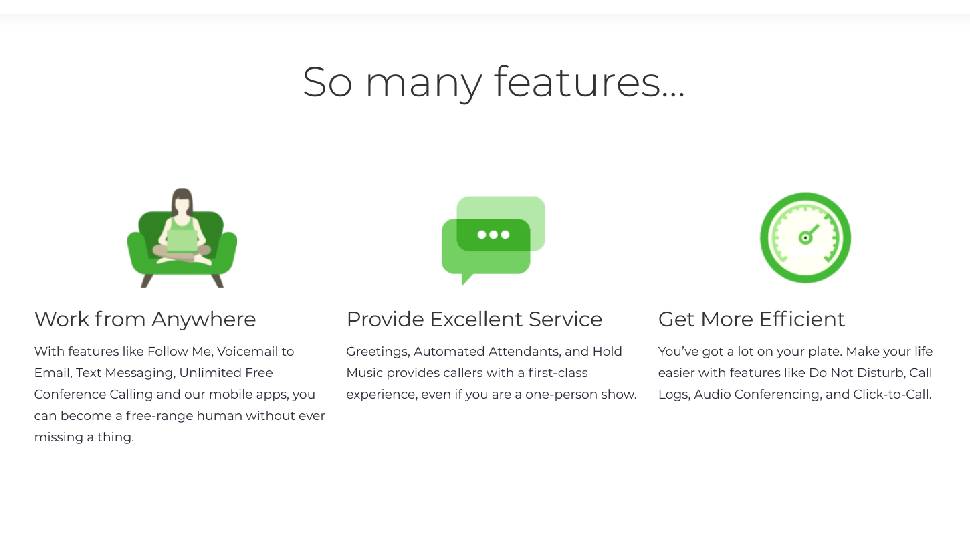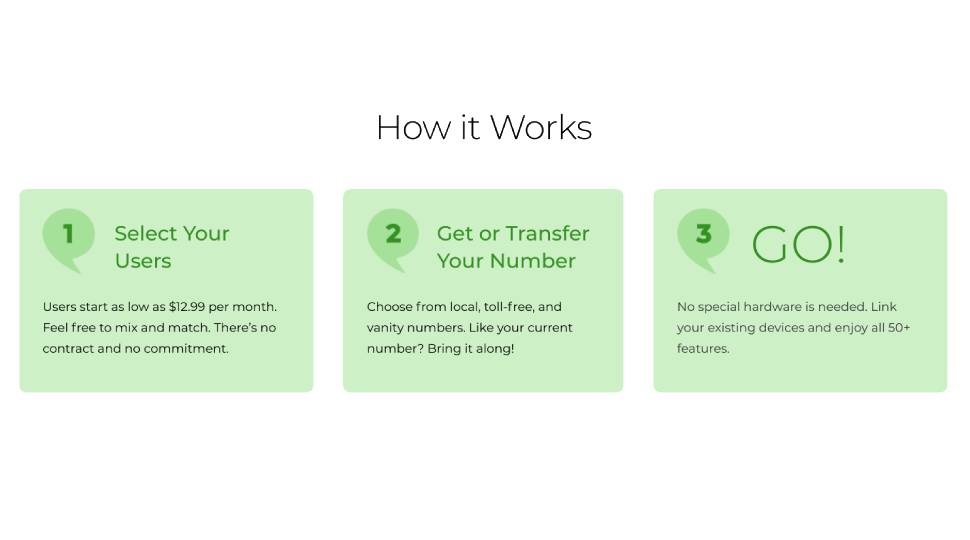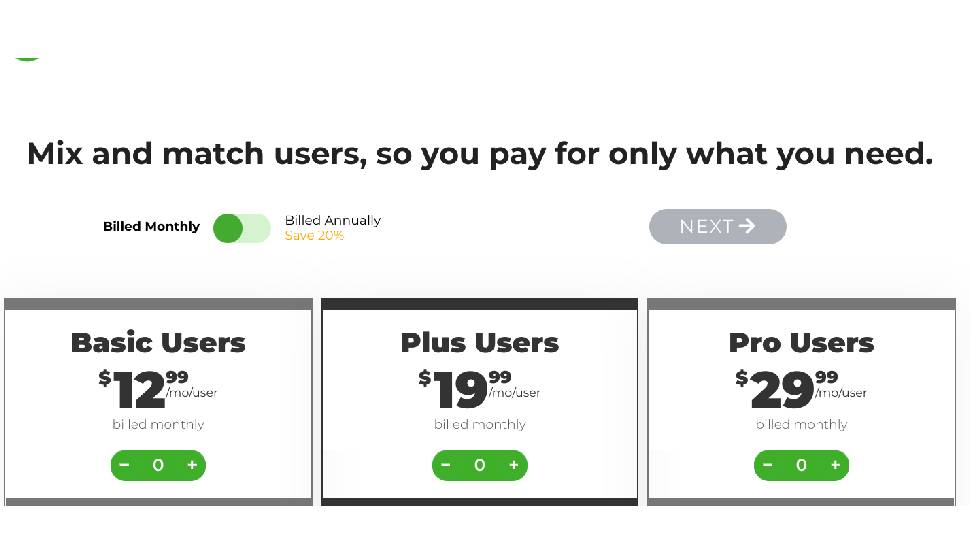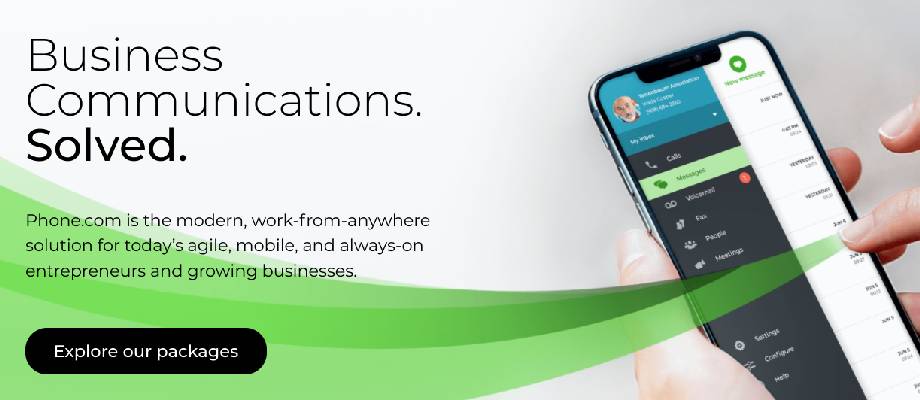TechRadar Verdict
A good offering for SMBs, but prices may rise significantly for larger firms.
Pros
- +
Straightforward interface
- +
All basic features included across pricing plans
Cons
- -
Lacks advanced collaboration tools
- -
Extra minutes and functionality could end up costing a lot
Why you can trust TechRadar
Phone.com was founded over a decade ago by Ari Rabban and Michael Mann with the ambition of providing effective communications at a price that small businesses could afford. Rabban has a wealth of experience in the IP-communications industry and continues to serve the company to this day as its CEO. He holds an MBA from Carnegie Mellon University, as well as degrees in law and economics - both from Tel Aviv University. Mann, meanwhile, is a serial entrepreneur that has become well-known in the domain name industry.
This is our all-in-one roundup looking at the Phone.com VoIP service. On this page, after our brief intro, you’ll find
(a) an overview of the Phone.com VoIP service and its Key Features
(b) a look at the Installation and Setup process
(c) a look at Phone.com's various Pricing Plans
You can jump to the review section that interests you most by clicking on the links in the bar at the top of this page, but bear in mind that this article is really designed to be read all the way through, as businesses will benefit from assessing the service in its entirety before deciding if it meets their needs.
Mann has now left the company but Rabban has been joined by several other talented individuals, from product engineers to customer service professionals, as part of a enlarged corporate team. Earlier this year, Phone.com announced that it had benefitted from a pandemic-related surge in user numbers - topping 40,000 customers for the first time.
The COVID-19 crisis forced many businesses to enact remote or hybrid working policies without warning, increasing their reliance on digital tools for communication and collaboration. This has provided an unexpected boon for VoIP providers like Phone.com. In particular, Rabban notes that there has been a noticeable uptick in mental healthcare practitioners using the Phone.com service. The platform’s tight integration with some of the best CRM software solutions has also helped with a more general increase in user numbers.
Customers old and new are likely to be broadly satisfied with Phone.com’s offering. Most of the basic VoIP features that companies have come to expect are included here, although some more advanced offerings have been neglected. More troubling may be the fact that some of the features that are available must be purchased as additional extras - at extra cost. However, these are minor grumbles. For the most part, Phone.com users will find a flexible VoIP service that is easy to set up and offers good audio quality.
- Best cloud phone systems: buy a business PBX system in the cloud
- Best business phone services
- The best VoIP phones for the small business and home office
Key features

A Phone.com account comes bundled with more than 50 features (which goes to show just how much the VoIP landscape has evolved). Unlike some other VoIP providers, Phone.com provides equal access to all its core features regardless of the pricing plan that individuals are signed up to. This means that users will be able to access call routing, call queues, forwarding, screening, and numerous other features even on the Basic plan.
While the feature list may not be as extensive as some of the other VoIP platforms we’ve reviewed, the fact that Phone.com largely does not discriminate between Basic and Pro users is a nice touch. Other core features include an Address Book that allows you to sync your contacts with your Phone.com address book and conduct calls or send SMS messages directly from within your Phone.com account. In addition, you can save your contacts into different groups so you can manage your contacts any way you see fit.
Phone.com also permits conference calling with up to 300 participants. Given the nature of remote work, particularly at large companies, conference calls have become an essential feature of the modern workplace. With Phone.com, conference calls are easy to set up, with individuals receiving a dedicated number for their password-protected conference bridge. For organizations that receive a lot of leads and customer engagements through their website, Phone.com also boasts a “click-to-call” feature. This allows for the embedding of a small piece of code on the company website that gives customers a quick way of making a call simply by entering their own number. Phone.com uses this information to automatically make an outbound call that connects customers directly with the business.
Sign up to the TechRadar Pro newsletter to get all the top news, opinion, features and guidance your business needs to succeed!
Other features include a dial-by-name directory, do not disturb, and an E911 service where it is available. The dial-by-name directory provides a computer-generated, auto-attendant voice that asks callers to enter the first or last name of the person they're trying to reach. The auto-attendant will then read the individual’s name and extension to the caller. The do-not-disturb feature sends calls directly to voicemail at the press of a button. And, providing Phone.com knows the physical location of your IP Phone, an e911 service is also available.
Installation and Setup

One of the best things about Phone.com’s VoIP offering is its simplicity. Getting set up is straightforward, with individuals simply selecting the number of users, with no commitment or contract required. Then, it’s up to users to choose their phone number, selecting from local, toll-free, and vanity numbers. Alternatively, if you’ve already got a phone number that you are reluctant to part with, you can bring that with you when moving to Phone.com.
Really that’s all there is to the set up process with Phone.com. No special hardware is required and it's easy to link your existing devices and gain access to all 50-plus features on offer. As wth many VoIP services, installation is seamless. Because of the way VoIP communication works with information being sent via the internet instead of tradition phone cables, there is no wiring or porting to manage. In fact, Phone.com will allow you to lease one of its own plug-and-play IP phones for added convenience.
Of course, many users may decide that they have no need for a desk phone at all - or certainly not all of the time. In that case, Phone.com offers a softphone client for either smartphones or desktop devices. With either the Android or iOS apps, Phone.com account holders can ensure that they never miss a business call or text - even when they are away from their desks.
The softphone version of Phone.com’s VoIP solutions delivers convenient calling over mobile data and Wi-Fi networks, meaning you can easily transform your personal smartphone into a powerful business phone whenever you need to. Moreover, you can retain access to all your business voicemails, in one convenient place. It’s easy to separate your business and personal messages, and respond to calls, SMS messages, or even faxed documents.
Every Phone.com mobile extension comes with its own HD conference bridge as well, so collaboration opportunities persist eithen when using the softphone. Whether you are taking part in training sessions, webinars or team meetings, this is all facilitated through the Phone.com app. And, it’s possible to send and receive text mesages using any of your business phone numbers, maintain your work inbox and undertake group messages. Essentially, most VoIP features that you would normally expect to have at your desk can be accessed from your smartphone with Phone.com’s VoIP service.
Pricing plans

In terms of pricing, Phone.com’s customer offerings are certainly reasonable. All come with free mobile and desktop softphone clients, and are accompanied by free 30-day trials. This means that businesses can gain a feel for whether Phone.com is right for them before committing themselves. A number of VoIP services now offer free trial periods and it’s not a bad idea to utilize them given the sheer number of different VoIP solutions that are now available.
The Basic plan is charged at $12.99 per month, per user, and comes with 300 pooled minutes, one phone number per account, 1000 pooled text segments, video conferencing with up to 10 participants, and the 50 core features that have been mentioned above. The Plus plan, meanwhile, comes with all the aforementioned functionality plus unlimited minutes and text messages, video conferencing with up to 25 participants, is HIPAA compliant, allows for video recording, and is IP desk phone compatible. This will set users back $19.99 per user, per month.
Where things start to get really interesting, however, is with the Pro plan, which is charged at $29.99 per user, per month. This comes with several advanced features that aren’t included in the Basic and Plus versions of the Phone.com solution. These include call recording, call analytics, and CRM integration. If these are the sorts of features that are likely to be deemed essential at your organization, then it’s worth shopping around to see if other VoIP providers can supply them at a more afffordable price. Although Phone.com is certainly not expensive, having to pay extra for certain features may not be acceptable for some firms.
The Pro plan also allows up to 100 participants to take in video conferencing, which also comes with HiFi transcription, and the option of a whiteboard for in-meeting notes. The Pro version also comes with a voicemail transcription service.
Another bonus in terms of how Phone.com structures its pricing is that there is a lot of flexibility. Add-ons can be purchased as and when needed, such as an extra IP desk phone for $4.99 per line or additional minute bundles. While this does mean that larger businesses could potentially end up forking out a lot for the service, ultimately being able to pick and choose what additional features you need is a great option for SMBs.
Final verdict
Althouth Phone.com’s service may not have the number of collaborative features that some other VoIP platforms offer, it is still a great solution for SMBs. The core features work well and there’s flexibility in terms of acquiring additional minutes. Just make sure you keep an eye on the rising price tag as your user numbers go up.
- We've also highlighted the best VoIP providers
Barclay has been writing about technology for a decade, starting out as a freelancer with ITProPortal covering everything from London’s start-up scene to comparisons of the best cloud storage services. After that, he spent some time as the managing editor of an online outlet focusing on cloud computing, furthering his interest in virtualization, Big Data, and the Internet of Things.

